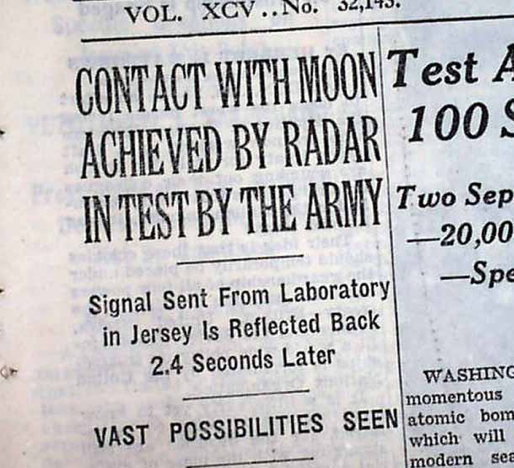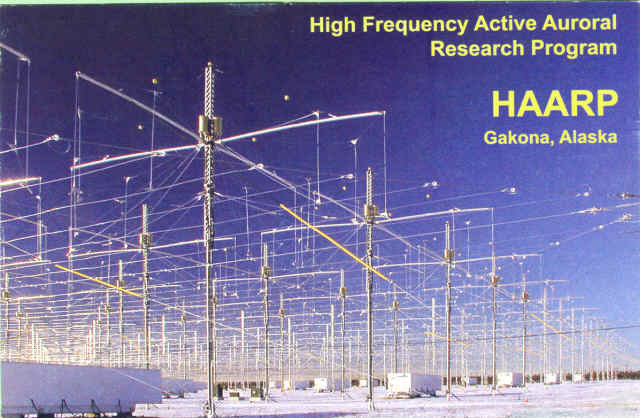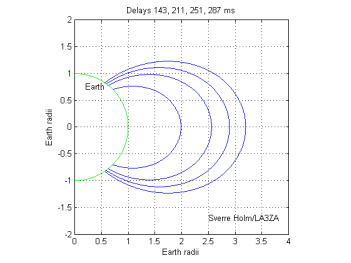Group 1: Signals Reflected above the Earth's Ionosphere and Near-Magnetosphere at Considerable Distance from the Earth, in Outer Space.
- Reflection from the Moon (and planets). The mean centre-to-centre distance from the Earth to the Moon is 384,403 km, subtracting the radii of the earth and the moon, the two-way delay may vary over 2x([363104 ... 405696]-6371-1737)/3e5 = [2.37 ... 2.65] seconds with a mean of about 2.5 seconds.
 The first Moon-bounced echoes were heard in 1946, and this can quite easily be done at VHF-UHF frequencies. Radio amateurs communicate via the moon from 50 MHz and up to 24 GHz.
The first Moon-bounced echoes were heard in 1946, and this can quite easily be done at VHF-UHF frequencies. Radio amateurs communicate via the moon from 50 MHz and up to 24 GHz. - Another moon signal that had about a 2.5 second delay was the communications between Houston ground control and Apollo 11 landing on the moon in 1969. It occured after mission control had spoken and before the response from the moon was heard. Listen at about 01:00 here. This is most likely at VHF frequency 259.7 MHz.
 In 2008, a facility with big enough antenna (300 by 365 m) and high enough power (3.6 MW), HAARP, was used to set a new record for how low in frequency on HF one can go and still get echoes from the moon: You can hear echoes at 7 MHz here.
In 2008, a facility with big enough antenna (300 by 365 m) and high enough power (3.6 MW), HAARP, was used to set a new record for how low in frequency on HF one can go and still get echoes from the moon: You can hear echoes at 7 MHz here.- Signals can also be bounced off all of the nearest planets and asteroids (Radar astronomy). A recent amateur experiment was succesful in getting echoes from Venus with delays of about 5 minutes.
- Reflection of signals with 4-8 seconds delay from the solid surfaces of large meteorites and the surrounding ionization clouds circulating around the Earth beyond the lunar orbit.
- [4] Reflection from clusters of ionized gas clouds in the Lagrange-Trojan regions. (Sun-earth L1, delay of about 10 sec or Moon-earth L4 or L5, delay of about 2.5 sec)
- Reflection from a toroidal surface formed by streams of charged particles emitted by the sun. The distance was supposed to be several tens times the earth's radius and the model predicts seasonal behavior with best reflection during spring and fall equinoxes. This is Størmer's original hypothesis from 1928 which he also elaborated on in his book from 1955 a few years before his death. The existence of such toroidal regions with trapped particles in the Earth's magnetic field has later been confirmed (the Van Allen radiation belt), but the distance is only 4-5 earth radii, i.e. only about 0.2 seconds round-trip time.
Group 2: Generation, Reflection and Propagation of Delayed Echo Signals in the Ionosphere or Near-Magnetosphere, i.e. in a System Associated with the Earth's Rotation.
- Signal retardation in the reflection regions of the ionosphere (the van der Pol hypothesis, 1928)
- Signal channeling along long curvilinear trajectories in the vicinity of ionized formations with oblong shapes,. which occur beyond the earth and rotate with it (Pedersen hypothesis, 1929).
 [1] The similarity between echoes and whistlers was noted early and it was proposed that the same mechanism could be responsible (Eckersley, 1928). Satellite measurements have confirmed the existence of magnetospheric ducts which give delays of 0.1-0.5 seconds but only up to frequencies of 4-5 MHz.
[1] The similarity between echoes and whistlers was noted early and it was proposed that the same mechanism could be responsible (Eckersley, 1928). Satellite measurements have confirmed the existence of magnetospheric ducts which give delays of 0.1-0.5 seconds but only up to frequencies of 4-5 MHz.
- Listen to examples here.
- Resonators formed by so-called "bubbles", stretched along the magnetic field, with a considerably reduced electron density and which are formed at 300-500 km and up to several thousands of km, moving with a speed of up to hundreds of m/s.
- [3] Conversion of the waves into longitudinal plasma waves and back in the vicinity of ionization and magnetic field inhomogeneities.
- Ionospheric resonators formed by e.g. voids in the F-region stratification, more probable at low and high latitudes.
- Resonant transfer of a portion of the energy of the electron flux, travelling in the reflecting region, a wave due to plasma-beam interaction and consequently some compensation of attenuation (analog to maser amplification). More probable in the auroral region where the electron fluxes are stronger.
- Plasma memory: the ionospheric equivalent to the spin echo effect in nuclear magnetic resonance.
- [5] Nonlinear interaction. Signals at two working frequencies, where the difference is close to the plasma frequency, interacting nonlinearly with the medium.
- Soliton-like solutions with compensation effects in the nonlinear and weakly dispersive media which lead to the occurence of long-lasting and form-preserving signals. The effect is possible in ducts or resonators.
- [2] Multiple round-the-world propagation of signals with focusing at the antipodal points (the Appleton hypothesis, 1928). In order to compensate for energy loss, it must be combined with focusing effects.
- Listen to an example of a short delay version here.
References
- C. Størmer, "Short wave echoes and the aurora borealis," Nature, No. 3079, Vol. 122, p. 681, Nov. 3, 1928.
- T. L. Eckersley, "Letter to the editor," Nature, vol. 122, p. 768, Nov. 17, 1928.
- B. v. d. Pol, "Short wave echoes and the aurora borealis," Nature, No. 3084, Vol. 122, pp. 878-879, Dec. 8, 1928.
- E. V. Appleton, "Short wave echoes and the aurora borealis," Nature, 122, p. 879, 1928.
- P. O. Pedersen, Wireless Echoes of Long Delay, Det Kgl. Danske Videnskabers Selskap. Math.-fys. Medd. 4 (5), pp 1-48, 1929.
- P. O. Pedersen, Wireless Echoes of Long Delay, Proc. Inst. Radio Eng., pp. 1750-1785, Oct. 1929
- C. Størmer, The Polar Aurora, 403 pp., Oxford Univ. Press, 1955.
- R. J. Vidmar and F. W. Crawford, "Long-delayed radio echoes: Mechanisms and observations," Journ. Geophys. Res., vol. 90, no. A2, pp. 1523-1530, Feb. 1985.
- A. G. Shlionskiy, "Radio echos with multisecond delays," Telecomm. and Radio Eng., Vol 44, No. 12, pp. 48-51, Dec. 1989.
First Created 6 November 2007.
© Sverre Holm, University of Oslo
(Also Norwegian radio amateur LA3ZA)